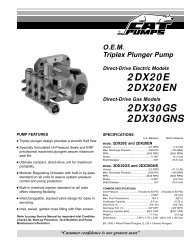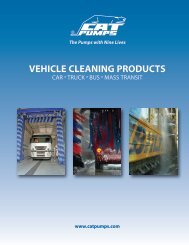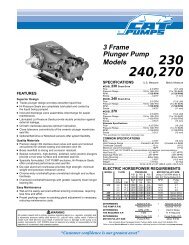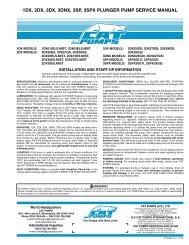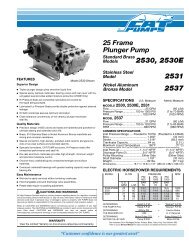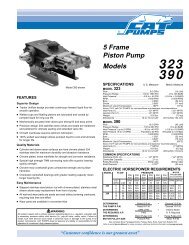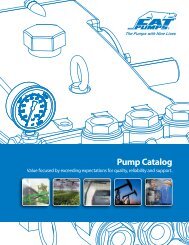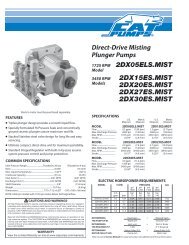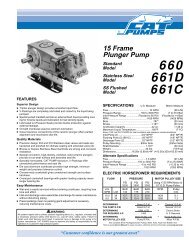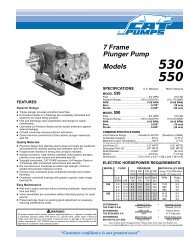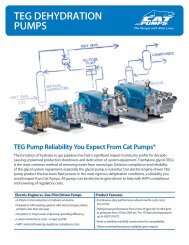Pump Service Manual for 8 and 28 FR Block-Style ... - Cat Pumps
Pump Service Manual for 8 and 28 FR Block-Style ... - Cat Pumps
Pump Service Manual for 8 and 28 FR Block-Style ... - Cat Pumps
You also want an ePaper? Increase the reach of your titles
YUMPU automatically turns print PDFs into web optimized ePapers that Google loves.
8 & <strong>28</strong>P<strong>FR</strong> PLUNGER PUMP SERVICE MANUAL<br />
SPECIFICATIONS: Maximum specifications refer to individual attributes. It is not<br />
implied that all maximums can be per<strong>for</strong>med simultaneously. If more than one<br />
maximum is considered, check with your CAT PUMPS supplier to confirm the proper<br />
per<strong>for</strong>mance <strong>and</strong> pump selection. Refer to individual pump Data Sheet <strong>for</strong> complete<br />
specifications, parts list <strong>and</strong> exploded view.<br />
LUBRICATION: Fill crankcase with special CAT PUMP oil per pump specifications<br />
[8P<strong>FR</strong> - 25 oz., <strong>28</strong>P<strong>FR</strong> - 84 oz.]. DO NOT RUN PUMP WITHOUT OIL IN<br />
CRANKCASE. Change initial fill after 50 hours running period. Thereafter, change oil<br />
every 3 months or 500 hour intervals.<br />
PUMP ROTATION: <strong>Pump</strong> was designed <strong>for</strong> <strong>for</strong>ward rotation to allow optimum lubrication<br />
of the crosshead area. Reverse rotation is acceptable if the crankcase oil<br />
level is increased slightly above center dot to assure adequate lubrication.<br />
PULLEY SELECTION: Select size of motor pulley required to deliver the desired flow<br />
from Horsepower Requirement <strong>and</strong> Pulley Selection Chart (refer to Tech Bulletin<br />
003 or individual Data Sheet).<br />
DRIVE SELECTION: The motor or engine driving the pump must be of adequate<br />
horsepower to maintain full RPM when the pump is under load. Select the electric<br />
motor from the Horsepower Requirement Chart according to required pump<br />
discharge flow, maximum pressure at the pump <strong>and</strong> drive losses of approximately<br />
3-5%. Consult the manufacturer of gas or diesel engine <strong>for</strong> selection of the proper<br />
engine size.<br />
MOUNTING: Mount the pump on a rigid, horizontal surface in a manner to permit<br />
drainage of crankcase oil. An uneven mounting surface will cause extensive damage<br />
to the pump base. To minimize piping stress, use appropriate flexible hose to<br />
inlet <strong>and</strong> discharge ports. Use the correct belt; make sure pulleys are aligned.<br />
Excessive belt tension may be harmful to the bearings. H<strong>and</strong> rotate pump be<strong>for</strong>e<br />
starting to be certain shaft <strong>and</strong> bearings are free moving.<br />
LOCATION: If the pump is used in extremely dirty or humid conditions, it is recommended<br />
pump be enclosed. Do not store or operate in excessively high temperature<br />
areas or enclosed without proper ventilation.<br />
INLET CONDITIONS: Refer to complete Inlet Condition Check-List in this manual<br />
be<strong>for</strong>e starting system. DO NOT STARVE THE PUMP OR RUN DRY.Temperatures<br />
above 130°F are permissible. Add 1/2 PSI inlet pressure per each degree F over<br />
130°F. Elastomer or RPM changes may be required. See Tech Bulletin 002 or call<br />
CAT PUMPS <strong>for</strong> recommendations.<br />
C.A.T.: Installation of a C.A.T. (Captive Acceleration Tube) is recommended in applications<br />
with stressful inlet conditions such as high temperatures, booster pump<br />
feed, long inlet lines or quick closing valves.<br />
DISCHARGE PLUMBING: OPEN ALL VALVES BEFORE STARTING SYSTEM to<br />
avoid deadhead overpressure condition <strong>and</strong> severe damage to the pump or system.<br />
Install a Pulsation Dampening device on the discharge head or in the discharge line<br />
as close to the head as possible. Be certain the pulsation dampener (Prrrrr-o-lator) is<br />
properly precharged <strong>for</strong> the system pressure (refer to individual Data Sheet).<br />
®<br />
8 <strong>FR</strong>AME BLOCK-STYLE MANIFOLD: 781, 781K<br />
<strong>28</strong> <strong>FR</strong>AME BLOCK-STYLE MANIFOLD: <strong>28</strong>31, <strong>28</strong>31K<br />
INSTALLATION AND START-UP INFORMATION<br />
Optimum per<strong>for</strong>mance of the pump is dependent upon the entire liquid system <strong>and</strong> will be obtained only<br />
with the proper selection, installation of plumbing, <strong>and</strong> operation of the pump <strong>and</strong> accessories.<br />
A reliable Pressure Gauge should be installed near the discharge outlet of the high<br />
pressure manifold. This is extremely important <strong>for</strong> adjusting pressure regulating<br />
devices <strong>and</strong> also <strong>for</strong> proper sizing of the nozzle or restricting orifice. The pump is<br />
rated <strong>for</strong> a maximum pressure; this is the pressure that is read at the<br />
discharge manifold of the pump, NOT AT THE GUN OR NOZZLE.<br />
Use PTFE thread tape or pipe thread sealant (sparingly) to connect accessories or<br />
plumbing. Exercise caution not to wrap tape beyond the last thread to avoid tape<br />
from becoming lodged in the pump or accessories. This condition will cause a malfunction<br />
of the pump or system.<br />
PRESSURE REGULATION: All systems require both a primary pressure regulating<br />
device (i.e., regulator, unloader) <strong>and</strong> a secondary pressure safety relief device (i.e.,<br />
pop-off valve, safety valve). The primary pressure device must be installed on the<br />
discharge side of the pump. The function of the primary pressure regulating device<br />
is to protect the pump from over pressurization, which can be caused by a plugged<br />
or closed off discharge line. Over pressurization can severely damage the pump,<br />
other system components <strong>and</strong> can cause bodily harm. The secondary safety relief<br />
device must be installed in-line between the primary device <strong>and</strong> the pump or on<br />
the opposite side of the manifold head.This will ensure pressure relief of the system<br />
if the primary regulating device fails. Failure to install such a safely device will<br />
void the warranty on the pump.<br />
If a large portion of the pumped liquid is by-passed (not used) when the high pressure<br />
system is running, this by-pass liquid should be routed to an adequately sized, baffled<br />
supply tank or to drain. If routed to the pump inlet, the by-pass liquid can quickly<br />
develop excessive heat <strong>and</strong> result in damage to the pump. A temperature<br />
control device to shut the system down within the pump limits or multiple THERMO<br />
VALVES must be installed in the by-pass line to protect the pump.<br />
NOZZLES: A worn nozzle will result in loss of pressure. Do not adjust pressure<br />
regulating device to compensate. Replace nozzle <strong>and</strong> reset regulating device to<br />
system pressure.<br />
PUMPED LIQUIDS: Some liquids may require a flush between operations or<br />
be<strong>for</strong>e storing. For pumping liquids other than water, contact your CAT PUMPS<br />
supplier.<br />
SPECIAL “K” MODELS: St<strong>and</strong>ard pumps have internal weep holes between the<br />
V-Packings <strong>and</strong> Lo-Pressure Seals allowing the pumped liquid to cool the back side<br />
of the packings. The “K” models do not have the internal weep holes <strong>and</strong> do not<br />
connect to the inlet side. They have special ports on both sides of the inlet manifold<br />
that can be fitted to an external flushing system to provide cooling <strong>and</strong> flushing.<br />
STORING: For extended storing or between use in cold climates, drain all pumped<br />
liquids from pump <strong>and</strong> flush with antifreeze solution to prevent freezing <strong>and</strong><br />
damage to the pump. DO NOT RUN PUMP WITH <strong>FR</strong>OZEN LIQUID (refer to Tech<br />
Bulletin 083).<br />
WARNING<br />
All systems require both a primary pressure regulating device (i.e., regulator, unloader) <strong>and</strong> a secondary pressure safety relief device (i.e., pop-off valve, safety valve).<br />
Failure to install such relief devices could result in personal injury or damage to the pump or to system components. CAT PUMPS does not assume any liability or responsibility<br />
<strong>for</strong> the operation of a customer’s high pressure system.<br />
World Headquarters<br />
CAT PUMPS<br />
1681 - 94th Lane N.E. Minneapolis, MN 55449-4324<br />
Phone (763) 780-5440 — FAX (763) 780-2958<br />
e-mail: techsupport@catpumps.com<br />
www.catpumps.com<br />
International Inquiries<br />
FAX (763) 785-4329<br />
e-mail: intlsales@catpumps.com<br />
®<br />
The <strong>Pump</strong>s with Nine Lives<br />
CAT PUMPS (U.K.) LTD.<br />
1 Fleet Business Park, S<strong>and</strong>y Lane, Church Crookham<br />
FLEET, Hampshire, GU52 8BF, Engl<strong>and</strong><br />
Phone Fleet 44 1252-622031 — Fax 44 1252-626655<br />
e-mail: sales@catpumps.co.uk<br />
N.V. CAT PUMPS INTERNATIONAL S.A.<br />
Heiveldekens 6A, B-2550 Kontich, Belgium<br />
Phone 32-3-450.71.50 — Fax 32-3-450.71.51<br />
e-mail: cpi@catpumps.be www.catpumps.be<br />
CAT PUMPS DEUTSCHLAND GmbH<br />
Buchwiese 2, D-65510 Idstein, Germany<br />
Phone 49 6126-9303 0 — Fax 49 6126-9303 33<br />
e-mail: catpumps@t-online.de www.catpumps.de<br />
PN 31997 Rev D 3833
781<br />
Removal of Valve <strong>Block</strong> Manifold<br />
SERVICING THE VALVES - 781/781K <strong>and</strong> <strong>28</strong>31/<strong>28</strong>31K<br />
(Discharge <strong>and</strong> Inlet Valves)<br />
Disassembly<br />
NOTE: Both the st<strong>and</strong>ard <strong>and</strong> the “K” versions are serviced<br />
in the same manner.<br />
1. To service the Discharge or Inlet Valve Assemblies, it is necessary<br />
to remove the Valve <strong>Block</strong> Manifold (VBM).<br />
2. Using an allen wrench, remove the Hex Socket Head screws<br />
(HSH) from the VBM.<br />
3. On the model 781, insert two M8 x 114 metric threaded bolts<br />
into the upper left <strong>and</strong> lower right intermediate holes on the<br />
VBM face. Thread in bolts until they make contact with Inlet<br />
Manifold/Discharge Manifold (IMDM) drilled holes. Continue<br />
threading until manifolds begin to separate. Support underside<br />
of VBM to avoid possible damage to ceramic plungers or<br />
plunger rods<br />
NOTE: The Valve Assemblies may stay with either the<br />
VBM or the IMDM.<br />
4. If the Inlet Valve Assemblies (lower chamber) stay in the<br />
IMDM or the Discharge Valve Assemblies (upper chamber)<br />
stay in the VBM, then grasp Spring Retainer tabs <strong>and</strong> pull<br />
assemblies from valve chambers.<br />
<strong>28</strong>31<br />
Removal of Valve Adapter from Inlet/Discharge<br />
Manifold<br />
781<br />
Removal of Valve Assembly from<br />
Inlet/Discharge Manifold<br />
<strong>28</strong>31<br />
Complete Inlet/Discharge Valve Assembly<br />
781<br />
Complete Inlet/Discharge Valve<br />
Assembly<br />
781<br />
Removal of VP Cylinder from<br />
Inlet/Discharge Manifold<br />
CAUTION: Be<strong>for</strong>e commencing with service, shut off drive (electric motor, gas or diesel engine) <strong>and</strong> turn off water supply to pump. Relieve all discharge<br />
line pressure by triggering gun or opening valve in discharge line.<br />
After servicing is completed, turn on water supply to pump, start drive, reset pressure regulating device <strong>and</strong> secondary valve, read system pressure on the<br />
gauge at the pump head. Check <strong>for</strong> any leaks, vibration or pressure fluctuations <strong>and</strong> resume operation.<br />
Inspect <strong>and</strong> service all system accessories on the same schedule as your pump.<br />
NOTE: The model <strong>28</strong>31 has Valve Adapters with O-Rings<br />
<strong>and</strong> Back-up-Rings that may remain with Inlet or<br />
Discharge Valve Assemblies when removed.<br />
5. If the Inlet Valve Assemblies (lower chamber) stay in the<br />
VBM or the Discharge Valve Assemblies (upper chamber)<br />
stay in the IMDM, then remove exposed O-Rings (781).<br />
Insert two screwdrivers into the groove on opposite sides of<br />
the Seat (781) or secondary groove on the Valve Adapter<br />
(<strong>28</strong>31) <strong>and</strong> pry from valve chamber.<br />
CAUTION: Exercise caution as the screwdrivers may<br />
score o-ring sealing area.<br />
6. To separate Valve Assemblies, insert screwdriver into<br />
Spring Retainer <strong>and</strong> press the backside of Valve until Seat<br />
separates from the Spring Retainer. Each assembly consists<br />
of a Retainer Washer, Spring Retainer, Spring, Valve, Seat,<br />
O-Ring <strong>and</strong> Back-up-Ring.<br />
7. On the model <strong>28</strong>31, remove Seat from the Valve Adapter by<br />
inserting reverse pliers through Seat opening <strong>and</strong> gently pull<br />
out.<br />
CAUTION: Exercise caution as the reverse pliers may<br />
score sealing areas.<br />
<strong>28</strong>31<br />
Removal of HPS Spacer from Inlet/Discharge Manifold
781<br />
V-Packing arrangement.<br />
Reassembly<br />
NOTE: For certain applications apply liquid gasket to the<br />
O-Ring crevices <strong>and</strong> seal surfaces. Refer to Tech Bulletin<br />
053 <strong>for</strong> model identification.<br />
1. Examine Retainer Washers <strong>for</strong> fatigue or wear <strong>and</strong> replace<br />
as needed.<br />
2. Examine Spring Retainers <strong>for</strong> internal wear or breaks in the<br />
structure <strong>and</strong> replace as needed.<br />
3. Examine Springs <strong>for</strong> fatigue or breaks <strong>and</strong> replace as needed.<br />
4. Examine Valves <strong>and</strong> Seats <strong>for</strong> grooves, pitting or wear <strong>and</strong><br />
replace as needed.<br />
5. Examine Seat O-Rings <strong>and</strong> Back-up-Rings <strong>for</strong> cuts or wear<br />
<strong>and</strong> replace as needed.<br />
6. On the model <strong>28</strong>31, examine Valve Adapter <strong>for</strong> external surface<br />
scoring or wear <strong>and</strong> replace as needed. Examine Valve<br />
Adapter O-Rings <strong>for</strong> cuts or wear <strong>and</strong> replace as needed.<br />
Install Back-up-Ring, then O-Ring into large groove.<br />
NOTE: A new Valve Assembly will come pre-assembled<br />
in the Valve kit. Continue with steps 11 through 13. If servicing<br />
from individual parts, follow steps 7 through 13.<br />
7. Place VBM on work surface with IMDM side up.<br />
8. On the model 781, install Back-up-Rings <strong>and</strong> O-Rings onto<br />
both the front <strong>and</strong> rear of the seat with the O-Rings to the<br />
outside. On the model <strong>28</strong>31, install Back-up-Ring <strong>and</strong><br />
O-Ring on the Seat with the O-Rings facing to the inside.<br />
<strong>28</strong>31<br />
Hi-Pressure Seal arrangement.<br />
781<br />
Lo-Pressure Seal <strong>and</strong> Adapter<br />
<strong>28</strong>31<br />
Lo-Pressure Seal<br />
781<br />
Plunger arrangement<br />
9. On the model 781, place Seat with O-Rings <strong>and</strong> Back-up-<br />
Rings on work surface with dish side up. Then place the<br />
Valve onto the Seat with dish side down/Spring tab up. On<br />
the model <strong>28</strong>31, place Valve Adapter on work surface with<br />
Back-up-Ring <strong>and</strong> O-Ring facing up. Press O-Ring side of<br />
Seat into Valve Adapter. Then place valve onto seat with dish<br />
side down.<br />
10. Place Spring on Valve <strong>and</strong> snap Spring Retainer onto Seat.<br />
11. On the model 781, insert Retainer Washer into valve chamber<br />
with curved side down. On the model <strong>28</strong>31, place flat<br />
Retainer Washer into valve chamber. Press Valve Assembly<br />
into the valve chamber until completely seated.<br />
12. On the model <strong>28</strong>31, insert O-Rings into groove at bottom of<br />
Valve Adapters.<br />
13. Support the VBM from the under side <strong>and</strong> align manifold with<br />
IMDM. Apply anti-seize to HSH screw threads <strong>and</strong> thread in<br />
h<strong>and</strong> tight. Torque in sequence to specifications in torque chart.<br />
<strong>28</strong>31<br />
Plunger arrangement
SERVICING THE SEALS - 781/781K <strong>and</strong> <strong>28</strong>31/<strong>28</strong>31K<br />
Disassembly<br />
NOTE: Both the st<strong>and</strong>ard <strong>and</strong> the “K” versions are serviced<br />
in the same manner. All parts necessary <strong>for</strong> servicing are<br />
included in the Seat Kit.<br />
CAUTION: Exercise caution as the reverse pliers may<br />
score sealing areas.<br />
1. To service the seals, it is necessary to remove both the VBM<br />
<strong>and</strong> IMDM. Follow the disassembly procedure found under<br />
SERVICING THE VALVES.<br />
NOTE: The V-Packing Cylinder (781) or Hi-Pressure Seal<br />
Spacers (HPS) (<strong>28</strong>31) may stay in the VBM or IMDM.<br />
2. Remove the exposed O-Rings <strong>and</strong> insert two screwdrivers<br />
into the grooves on opposite sides of the V-Packing Cylinder<br />
(781) or into the secondary groove on the HPS Spacer<br />
(<strong>28</strong>31) <strong>and</strong> pry from the chamber.<br />
CAUTION: Exercise caution as the screwdriver may<br />
score o-ring sealing area.<br />
3. On the model 781, remove Female Adapters from each<br />
chamber.<br />
4. On the model 781, use reverse pliers to remove three<br />
V-Packings <strong>and</strong> one Male Adapter from each V-Packing<br />
Cylinder.<br />
5. On the model <strong>28</strong>31, use reverse pliers to remove one<br />
Hi-Pressure Seal from each IMDM chamber.<br />
6. Invert IMDM <strong>and</strong> place on flat work surface with crankcase<br />
side up.<br />
7. On the model 781, use reverse pliers to remove three Inlet<br />
Adapter Assemblies by grasping the Inlet Adapter.<br />
8. Use reverse pliers to remove Lo-Pressure Seals from backside<br />
of Inlet Adapter (781) or the IMDM chamber (<strong>28</strong>31).<br />
Reassembly<br />
NOTE: For certain applications apply liquid gasket to the<br />
O-Ring crevices <strong>and</strong> seal surfaces. Refer to Tech Bulletin<br />
053 <strong>for</strong> model identification.<br />
NOTE: For st<strong>and</strong>ard installation, apply a small amount of<br />
oil to the outside edge of the LPS, HPS, VP, MA, FA <strong>for</strong><br />
ease of installation <strong>and</strong> to avoid damage.<br />
Models 781 <strong>and</strong> 781K<br />
1. Examine Lo-Pressure Seals <strong>for</strong> wear to the internal ridges,<br />
outer surfaces or <strong>for</strong> broken springs <strong>and</strong> replace as needed.<br />
2. Examine Inlet Adapters <strong>for</strong> scale build up or wear, <strong>and</strong> the<br />
Inlet Adapter O-Rings <strong>for</strong> cuts or deterioration <strong>and</strong> replace as<br />
needed.<br />
NOTE: When using alternate materials, the fit of the special<br />
materials may be snug <strong>and</strong> require gently driving the<br />
LPS into position with a cylinder of the same diameter to<br />
assure a square seating <strong>and</strong> no damage to the LPS.<br />
3. Press new Lo-Pressure Seals into the Inlet Adapters with the<br />
garter spring up.<br />
4. Press Inlet Adapter Assembly into each chamber of the<br />
IMDM with the garter spring down.<br />
5. Invert IMDM <strong>and</strong> place on flat work surface with crankcase<br />
side down.<br />
6. Examine the V-Packing Cylinder <strong>for</strong> scale build-up, wear <strong>and</strong><br />
replace as needed. Examine V-Packing Cylinder O-Rings<br />
<strong>and</strong> Back-up-Rings <strong>for</strong> cuts or deterioration <strong>and</strong> replace as<br />
needed.<br />
7. Examine Male <strong>and</strong> Female Adapters <strong>for</strong> wear <strong>and</strong> replace as<br />
needed.<br />
8. Examine V-Packings <strong>for</strong> frayed edges or wear <strong>and</strong> replace as<br />
needed.<br />
9. Place the Male Adapters into the V-Packing Cylinder with flat<br />
side down.<br />
10. Insert three new V-Packings into each V-Packing Cylinder<br />
with “V” groove down. The “V” will mate with “V side” of the<br />
Male Adapter.<br />
11. Position Female Adapter into the IMDM with “V” groove up.<br />
12. Press V-Packing Cylinder Assembly into IMDM center chambers<br />
with V-Packings facing into the manifold chamber.<br />
13. Support the IMDM from the under side <strong>and</strong> align the manifold<br />
bolt holes with crankcase holes. Apply Loctite ® 242 ® to HSH<br />
screw threads <strong>and</strong> thread in h<strong>and</strong> tight. Torque in sequence<br />
to specifications in torque chart.<br />
14. Support the VBM from the under side <strong>and</strong> align manifold with<br />
IMDM. Apply anti-seize to HSH screw threads <strong>and</strong> thread in<br />
h<strong>and</strong> tight. Torque in sequence to specifications in torque<br />
chart.<br />
TORQUE SEQUENCE<br />
Models <strong>28</strong>31 <strong>and</strong> <strong>28</strong>31K<br />
1. Examine Lo-Pressure Seals <strong>for</strong> wear to the internal ridges,<br />
outer surfaces or <strong>for</strong> broken springs <strong>and</strong> replace as needed.<br />
2. Press new Lo-Pressure Seals into IMDM with the garter<br />
spring down.<br />
NOTE: When using alternate materials, the fit of the special<br />
materials may be snug <strong>and</strong> require gently driving the<br />
LPS into position with a cylinder of the same diameter to<br />
assure a square seating <strong>and</strong> no damage to the LPS.<br />
3. Invert IMDM <strong>and</strong> place on flat work surface with crankcase<br />
side down.<br />
4. Examine HPS Spacer <strong>for</strong> scale build-up, wear <strong>and</strong> replace as<br />
needed. Examine HPS Spacer O-Rings <strong>for</strong> cuts or deterioration<br />
<strong>and</strong> replace as needed.<br />
5. Examine Hi-Pressure Seals <strong>for</strong> frayed edges or wear <strong>and</strong><br />
replace as needed.<br />
6. Press Hi-Pressure Seal into each IMDM center chamber with<br />
metal backing facing down into the manifold chamber.<br />
7. Press HPS Spacer into each center manifold chamber with<br />
secondary groove facing out.<br />
8. Support the IMDM from the under side <strong>and</strong> align the manifold<br />
bolt holes with crankcase holes. Apply Loctite ® 242 ® to HSH<br />
screw threads <strong>and</strong> thread in h<strong>and</strong> tight. Torque in sequence<br />
to specifications in torque chart.<br />
9. Support the VBM from the under side <strong>and</strong> align manifold with<br />
IMDM. Apply anti-seize to HSH screw threads <strong>and</strong> thread in<br />
h<strong>and</strong> tight. Torque in sequence to specifications in torque<br />
chart.<br />
TORQUE SEQUENCE<br />
13 5 7 11<br />
1 3<br />
9 10<br />
4 2<br />
12 8 6 14<br />
13 5 7 15<br />
9 1 3 11<br />
12 4 2 10<br />
16 8 6 14
SERVICING THE PLUNGERS - 781/781K <strong>and</strong> <strong>28</strong>31/<strong>28</strong>31K<br />
Disassembly<br />
NOTE: Both the st<strong>and</strong>ard <strong>and</strong> the “K” versions are serviced<br />
in the same manner.<br />
1. To service the plungers, it is necessary to remove both the<br />
VBM <strong>and</strong> IMDM. Follow the disassembly procedure found<br />
under SERVICING THE VALVES.<br />
2. Remove the one piece Seal Retainer from each Plunger Rod.<br />
3. Using a Hex tool, loosen the Plunger Retainers about three to<br />
four turns.<br />
4. Push the Ceramic Plungers back towards the crankcase to<br />
separate from the Plunger Retainers <strong>and</strong> proceed with unthreading<br />
the Plunger Retainers by h<strong>and</strong>.<br />
5. Remove Plunger Retainers, O-Rings, Back-up-Rings <strong>and</strong><br />
Gaskets.<br />
NOTE: Plunger Retainer Studs may stay on Plunger<br />
Rods or come off with Plunger Retainers.<br />
6. Remove Ceramic Plungers, Keyhole Washers <strong>and</strong> Barrier<br />
Slingers.<br />
Reassembly<br />
1. Visually inspect Crankcase Oil Seals <strong>for</strong> deterioration or leaks<br />
<strong>and</strong> contact CAT PUMPS <strong>for</strong> assistance with replacement.<br />
See SERVICING THE CRANKCASE section.<br />
2. Examine Plunger Retainers, Studs, Barrier Slingers <strong>and</strong><br />
Keyhole Washers <strong>for</strong> wear <strong>and</strong> replace as needed.<br />
3. Slide Barrier Slingers over Plunger Retainer Studs with concave<br />
side away from crankcase.<br />
4. Slide Keyhole Washers over Plunger Retainer Studs with<br />
split ends facing downward.<br />
5. Examine Ceramic Plungers <strong>for</strong> scoring, scale build-up, chips<br />
or cracks <strong>and</strong> replace as needed.<br />
6. Slide Ceramic Plungers over Plunger Retainer Studs.<br />
NOTE: Plunger can only be installed in one direction. Do<br />
not <strong>for</strong>ce onto Plunger Rod.<br />
7. Examine Gaskets, O-Rings <strong>and</strong> Back-up-Rings <strong>for</strong> cuts or<br />
wear <strong>and</strong> replace as needed.<br />
8. Install Gaskets first, then O-Rings <strong>and</strong> Back-up-Rings onto<br />
Plunger Retainers.<br />
NOTE: Lubricate O-Rings <strong>and</strong> Back-up-Rings <strong>for</strong> ease in<br />
installation <strong>and</strong> to reduce possible damage.<br />
9. Apply Loctite ® 242 ® to exposed threaded end of Plunger<br />
Retainer Studs. Thread on Plunger Retainer <strong>and</strong> torque per<br />
chart.<br />
10. On the model 781, install Seal Retainers with drain slots facing<br />
the crankcase with openings to the top <strong>and</strong> bottom. On the<br />
model <strong>28</strong>31 the drain openings must face the manifold.<br />
11. Support the IMDM from the under side <strong>and</strong> align manifold<br />
bolt holes with crankcase holes. Apply Loctite ® 242 ® to HSH<br />
screws threads <strong>and</strong> thread in h<strong>and</strong> tight. Torque in sequence<br />
to specifications in torque chart.<br />
12. Support the VBM from the under side <strong>and</strong> align manifold with<br />
IMDM. Apply anti-seize to HSH screw threads <strong>and</strong> thread in<br />
h<strong>and</strong> tight. Torque in sequence to specifications in torque<br />
chart.<br />
SERVICING THE CRANKCASE SECTION - 781/781K<br />
<strong>and</strong> <strong>28</strong>31/<strong>28</strong>31K<br />
NOTE: Both the st<strong>and</strong>ard <strong>and</strong> the “K” versions are serviced<br />
in the same manner.<br />
1. While manifolds, plungers <strong>and</strong> seal retainers are removed examine<br />
crankcase oil seals <strong>for</strong> leaking <strong>and</strong> wear.<br />
2. Check <strong>for</strong> any signs of leaking at Rear Cover, Drain Plug,<br />
<strong>and</strong> Bubble Oil Gauge (781) or Rear Cover, Drain Plug, <strong>and</strong><br />
Dipstick (<strong>28</strong>31).<br />
3. Check oil level <strong>and</strong> <strong>for</strong> evidence of water in oil. Change<br />
crankcase oil on a regular schedule. See Preventative<br />
Maintenance Check-List.<br />
4. Rotate crankshaft by h<strong>and</strong> to feel <strong>for</strong> smooth bearing movement.<br />
5. Examine crankshaft oil seals externally <strong>for</strong> drying, cracking or<br />
leaking.<br />
6. Contact CAT PUMPS or your local distributor if crankcase<br />
service is required. Refer to Tech Bulletin 035.<br />
Loctite <strong>and</strong> 242 are registered trademarks of the Henkel Corporation.
PREVENTATIVE MAINTENANCE CHECK-LIST<br />
Check Daily Weekly 50 hrs. 500 hrs.* 1500 hrs.** 3000 hrs.**<br />
Clean Filters x<br />
Oil Level/Quality x<br />
Oil Leaks x<br />
Water Leaks x<br />
Belts, Pulley x<br />
Plumbing x<br />
Initial Oil Change x<br />
Oil Change x<br />
Seal Change x<br />
Valve Change x<br />
Accessories x<br />
* If other than CAT PUMPS special multi-viscosity ISO68 oil is used,<br />
change cycle should be every 300 hours.<br />
** Each system’s maintenance cycle will be exclusive. If system per<strong>for</strong>mance<br />
decreases, check immediately. If no wear at 1500 hours,<br />
check again at 2000 hours <strong>and</strong> each 500 hours until wear is observed.<br />
Valves typically require changing every other seal change.<br />
Duty cycle, temperature, quality of pumped liquid <strong>and</strong> inlet feed<br />
conditions all effect the life of pump wear parts <strong>and</strong> service cycle.<br />
** Remember to service the regulator/unloader at each seal servicing<br />
<strong>and</strong> check all system accessories <strong>and</strong> connections be<strong>for</strong>e resuming<br />
operation.<br />
TORQUE CHART<br />
<strong>Pump</strong> Item Torque<br />
<strong>Pump</strong> Model Thread Tool Size [P/N] in.lbs. ft.lbs. Nm<br />
Plunger Retainer<br />
781 M5 M11 Hex 55 4.4 6<br />
<strong>28</strong>31 M7 M14 Hex 90 7.2 10<br />
Inlet/Discharge Manifold Screws<br />
781 M10 M8 Allen [33046] 250 20.8 <strong>28</strong><br />
<strong>28</strong>31 M12 M10 Allen [33047] 355 29.6 40<br />
Valve <strong>Block</strong> Manifold Screws<br />
781 M10 M8 Allen [33046] 250 20.8 <strong>28</strong><br />
<strong>28</strong>31 M12 M10 Allen [33047] 355 29.6 40<br />
Crankcase Cover/Bearing Cover Screws<br />
781 M6 M10 Hex [25082] 115 9.4 13<br />
<strong>28</strong>31<br />
Connecting Rod Screws<br />
M8 M13 Hex [25324] 115 9.4 13<br />
781, <strong>28</strong>31<br />
Bubble Oil Gauge<br />
M8 M13 Hex [25324] 130 10.8 15<br />
781, <strong>28</strong>31 M<strong>28</strong> Oil Gauge Tool [44050] 45 3.6 5<br />
TECHNICAL BULLETIN REFERENCE CHART<br />
No. Subject Models<br />
002 Inlet Pressure VS Liquid Temperature All Models<br />
003 Power Unit Drive Packages 3P<strong>FR</strong> - 68P<strong>FR</strong>, 10<strong>FR</strong> - 60<strong>FR</strong><br />
024 Lubrication of Lo-Pressure Seals All Models<br />
035 Servicing Crankcase Section 7P<strong>FR</strong> - 60P<strong>FR</strong><br />
036 Cylinder <strong>and</strong> Plunger Reference Chart All Models<br />
043 LPS <strong>and</strong> HPS Servicing All Plunger Models<br />
053 Liquid Gasket All Plunger NAB-S.S. Models<br />
064 By-Pass Hose Sizing All Unloaders/Regulators<br />
074 Torque Chart Piston <strong>and</strong> Plunger <strong>Pump</strong>s<br />
077 Oil Drain Kit All Models (except 2SF/4SF)<br />
083 Winterizing a <strong>Pump</strong> All Models<br />
085 M8 Keyway 25<strong>FR</strong>, 25P<strong>FR</strong>, <strong>28</strong>P<strong>FR</strong><br />
INLET CONDITION CHECK-LIST<br />
Review Be<strong>for</strong>e Start-Up<br />
Inadequate inlet conditions can cause serious malfunctions in the best designed<br />
pump. Surprisingly, the simplest of things can cause the most severe problems or go<br />
unnoticed to the unfamiliar or untrained eye. REVIEW THIS CHECK-LIST BEFORE<br />
OPERATION OF ANY SYSTEM. Remember, no two systems are alike, so there can<br />
be no ONE best way to set-up a system. All factors must be carefully considered.<br />
INLET SUPPLY should exceed the maximum flow being delivered by the pump to<br />
assure proper per<strong>for</strong>mance.<br />
❏ Open inlet shut-off valve <strong>and</strong> turn on water supply to avoid starving pump.<br />
DO NOT RUN PUMP DRY.<br />
❏ Temperatures above 130°F are permissible. Add 1/2 PSI inlet pressure per each<br />
degree F over 130°F. Elastomer or RPM changes may be required. See Tech<br />
Bulletin 002 or call CAT PUMPS <strong>for</strong> recommendations.<br />
❏ Avoid closed loop systems especially with high temperature, ultra-high pressure<br />
or large volumes. Conditions vary with regulating/unloader valve.<br />
❏ Low vapor pressure liquids, such as solvents, require a booster pump <strong>and</strong> C.A.T.<br />
to maintain adequate inlet supply.<br />
❏ Higher viscosity liquids require a positive head <strong>and</strong> a C.A.T. to assure adequate<br />
inlet supply.<br />
❏ Higher temperature liquids tend to vaporize <strong>and</strong> require positive heads <strong>and</strong><br />
C.A.T. to assure adequate inlet supply.<br />
❏ When using an inlet supply reservoir, size it to provide adequate liquid to accommodate<br />
the maximum output of the pump, generally a minimum of 6-10 times the<br />
GPM (however, a combination of system factors can change this requirement);<br />
provide adequate baffling in the tank to eliminate air bubbles <strong>and</strong> turbulence;<br />
install diffusers on all return lines to the tank.<br />
INLET LINE SIZE should be adequate to avoid starving the pump.<br />
❏ Line size must be a minimum of one size larger than the pump inlet fitting. Avoid<br />
tees, 90 degree elbows or valves in the inlet line of the pump to reduce the risk of<br />
flow restriction <strong>and</strong> cavitation.<br />
❏ The line MUST be a FLEXIBLE hose, NOT a rigid pipe, <strong>and</strong> rein<strong>for</strong>ced on SUCTION<br />
systems to avoid collapsing.<br />
❏ The simpler the inlet plumbing the less the potential <strong>for</strong> problems. Keep the<br />
length to a minimum, the number of elbows <strong>and</strong> joints to a minimum (ideally no<br />
elbows) <strong>and</strong> the inlet accessories to a minimum.<br />
❏ Use pipe sealant to assure air-tight, positive sealing pipe joints.<br />
INLET PRESSURE should fall within the specifications of the pump.<br />
❏ Acceleration loss of liquids may be increased by high RPM, high temperatures,<br />
low vapor pressures or high viscosity <strong>and</strong> may require pressurized inlet <strong>and</strong><br />
C.A.T. to maintain adequate inlet supply. DO NOT USE C.A.T. WITH SUCTION<br />
INLET.<br />
❏ Optimum pump per<strong>for</strong>mance is obtained with +20 PSI (1.4 BAR) inlet pressure<br />
<strong>and</strong> a C.A.T. <strong>for</strong> certain applications. With adequate inlet plumbing, most pumps<br />
will per<strong>for</strong>m with flooded suction. Maximum inlet pressure is 70 PSI (4.9 BAR).<br />
❏ After prolonged storage, pump should be rotated by h<strong>and</strong> <strong>and</strong> purged of air to<br />
facilitate priming. Disconnect the discharge port <strong>and</strong> allow liquid to pass through<br />
pump <strong>and</strong> measure flow.<br />
❏ “K” versions are suitable <strong>for</strong> high inlet pressures. Consult CAT PUMPS.<br />
INLET ACCESSORIES are designed to protect against over pressurization, control<br />
inlet flow, contamination or temperature <strong>and</strong> provide ease of servicing.<br />
❏ A shut-off valve is recommended to facilitate maintenance.<br />
❏ Installation of a C.A.T. is essential in applications with stressful conditions such<br />
as high temperatures, booster pump feed or long inlet lines. Do not use C.A.T.<br />
with negative inlet pressure.<br />
❏ A st<strong>and</strong> pipe can be used in some applications to help maintain a positive head<br />
at the pump inlet line.<br />
❏ Inspect <strong>and</strong> clean inlet filters on a regular schedule to avoid flow restriction.<br />
❏ A pressure transducer is necessary to accurately read inlet pressure. Short<br />
term, intermittent cavitation will not register on a st<strong>and</strong>ard gauge.<br />
❏ All accessories should be sized to avoid restricting the inlet flow.<br />
❏ All accessories should be compatible with the solution being pumped to prevent<br />
premature failure or malfunction.<br />
❏ Optional inlet protection can be achieved by installing a pressure cut off switch<br />
between the inlet filter <strong>and</strong> the pump to shut off pump when there is no positive<br />
inlet pressure.<br />
❏ “K” versions are suitable <strong>for</strong> high temperatures <strong>and</strong> containment of harmful<br />
liquids. Consult CAT PUMPS <strong>for</strong> optional flushing <strong>and</strong> cooling accessory.<br />
BY-PASS TO INLET Care should be exercised when deciding the method of by-pass<br />
from control valves.<br />
❏ It is recommended the by-pass be directed to a baffled reservoir tank, with at<br />
least one baffle between the by-pass line <strong>and</strong> the inlet line to the pump.<br />
❏ Although not recommended, by-pass liquid may be returned to the inlet line of the<br />
pump if the system is properly designed to protect your pump. When a pulsation<br />
dampener is used, a PRESSURE REDUCING VALVE must be installed on the<br />
inlet line (BETWEEN THE BY-PASS CONNECTION AND THE INLET TO THE<br />
PUMP) to avoid excessive pressure to the inlet of the pump. It is also recommended<br />
that a THERMO VALVE be used in the by-pass line to monitor the temperature<br />
build-up in the by-pass loop to avoid premature seal failure.<br />
❏ A rein<strong>for</strong>ced, flexible, low pressure hose rated up to 300 PSI should be used <strong>for</strong><br />
routing by-pass back to the pump inlet.<br />
❏ Caution should be exercised not to undersize the by-pass hose diameter <strong>and</strong><br />
length. Refer to Technical Bulletin 064 <strong>for</strong> additional in<strong>for</strong>mation on the size <strong>and</strong><br />
length of the by-pass line.<br />
❏ Check the pressure in the by-pass line to avoid over pressurizing the inlet.<br />
❏ The by-pass line should be connected to the pump inlet line at a gentle angle of<br />
45° or less <strong>and</strong> no closer than 10 times the pump inlet port diameter e.g. 1-1/2"<br />
port size = 15" distance from pump inlet port.
Water*<br />
Flow<br />
Gal/Min<br />
HOSE <strong>FR</strong>ICTION LOSS<br />
PRESSURE DROP IN PSI PER 100 FT OF HOSE<br />
WITH TYPICAL WATER FLOW RATES<br />
Hose Inside Diameters, Inches<br />
1/4 5/16 3/8 1/2 5/8 3/4 1"<br />
0.5 16 5 2<br />
1 54 20 7 2<br />
2 180 60 25 6 2<br />
3 380 120 50 13 4 2<br />
4 220 90 24 7 3<br />
5 320 130 34 10 4<br />
6 220 52 16 7 1<br />
8 300 80 25 10 2<br />
10 450 120 38 14 3<br />
15 900 250 80 30 7<br />
20 1600 400 121 50 12<br />
25 650 200 76 19<br />
30 250 96 24<br />
40 410 162 42<br />
50 600 235 62<br />
60 370 93<br />
*At a fixed flow rate with a given size hose, the pressure drop across a given hose length<br />
will be directly proportional. A 50 ft. hose will exhibit one-half the pressure drop of a 100<br />
ft. hose. Above values shown are valid at all pressure levels.<br />
Water<br />
GPM<br />
1<br />
2<br />
3<br />
5<br />
8<br />
10<br />
15<br />
25<br />
40<br />
60<br />
80<br />
100<br />
WATER LINE PRESSURE LOSS<br />
PRESSURE DROP IN PSI PER 100 FEET<br />
Steel Pipe—Nominal Dia.<br />
1/4 3/8 1/2 3/4 1 1 1 /4 1 1 /2<br />
8.5 1.9<br />
30 7.0 2.1<br />
60 14 4.5 1.1<br />
150 36 12 2.8<br />
330 86 <strong>28</strong> 6.7 1.9<br />
520 130 43 10 3.0<br />
270 90 21 6.2 1.6<br />
670 240 56 16 4.2 2.0<br />
66 17 8.0<br />
37 17<br />
52 29<br />
210 107 48<br />
Brass Pipe—Nominal Dia.<br />
1/4 3/8 1/2 3/4 1 11 /4 11 6.0 1.6<br />
20 5.6 1.8<br />
/2<br />
40 11 3.6<br />
100 <strong>28</strong> 9.0 2.2<br />
220 62 21 5.2 1.6<br />
320 90 30 7.8 2.4<br />
190 62 16 5.0 1.5<br />
470 150 40 12 3.8 1.7<br />
39 11 5.0<br />
23 11<br />
40 19<br />
61 <strong>28</strong><br />
Copper Tubing O.D. Type L<br />
1/4 3/8 1/2 5/8 3/4 7/8<br />
120 13 2.9 1.0<br />
400 45 10 3.4 1.3<br />
94 20 6.7 2.6<br />
230 50 17 6.1 3.0<br />
500 120 40 15 6.5<br />
180 56 22 10<br />
120 44 20<br />
330 110 50<br />
550 200 88<br />
RESISTANCE OF VALVES AND FITTINGS<br />
Nominal<br />
Pipe<br />
Size<br />
Inches<br />
Inside<br />
Diameter<br />
Inches<br />
Gate<br />
Valve<br />
Globe<br />
Valve<br />
Angle<br />
Valve<br />
45˚<br />
Elbow<br />
90˚<br />
Elbow<br />
180˚<br />
Close<br />
Ret<br />
Tee<br />
Thru<br />
Run<br />
1/2 0.622 0.41 18.5 9.3 0.78 1.67 3.71 0.93 3.33<br />
3/4 0.824 0.54 24.5 12.3 1.03 2.21 4.90 1.23 4.41<br />
1 1.049 0.69 31.2 15.6 1.31 2.81 6.25 1.56 5.62<br />
11 /4 1.380 0.90 41.0 20.5 1.73 3.70 8.22 2.06 7.40<br />
11 /2 1.610 1.05 48.0 24.0 2.15 4.31 9.59 2.40 8.63<br />
2 2.067 1.35 61.5 30.8 2.59 5.55 12.30 3.08 11.60<br />
2 1 /2 2.469 1.62 73.5 36.8 3.09 6.61 14.70 3.68 13.20<br />
3 3.068 2.01 91.5 45.8 3.84 8.23 18.20 4.57 16.40<br />
4 4.026 2.64 120.0 60.0 5.03 10.80 23.90 6.00 21.60<br />
Arriving at a total line pressure loss, consideration should then be given to<br />
pressure loss created by valves, fittings <strong>and</strong> elevation of lines.<br />
If a sufficient number of valves <strong>and</strong> fittings are incorporated in the system to<br />
materially affect the total line loss, add to the total line length, the equivalent<br />
length of line of each valve or fitting.<br />
TYPICAL RESERVOIR TANK<br />
RECOMMENDED 6 TO 10 TIMES SYSTEM CAPACITY<br />
Flexible Hose<br />
to <strong>Pump</strong><br />
FILTER<br />
→<br />
→<br />
MIN. 4"<br />
Equivalent Length of St<strong>and</strong>ard Pipe in Feet<br />
Bypass Line<br />
(from regulator or unloader)<br />
Level Sensing<br />
Device<br />
→<br />
→<br />
MIN. 4"<br />
Minimum<br />
Liquid<br />
Level<br />
→<br />
Tee<br />
Thru<br />
Branch<br />
1.5 x D (Min.)<br />
Minimum Two Baffles<br />
Sealed at Bottom<br />
Supply Line<br />
T (Dia of pipe)<br />
X D<br />
→<br />
→<br />
→<br />
→<br />
Bypass Line<br />
(from regulator or<br />
unloader)<br />
H<strong>and</strong>y Formulas to Help You<br />
Q. How can I find the RPM needed to get specific GPM<br />
(Gallons Per Minute) I want?<br />
Rated RPM<br />
A. Desired RPM = Desired GPM x<br />
Rated GPM<br />
Q. I have to run my pump at a certain RPM. How do I figure<br />
the GPM I’ll get?<br />
Rated GPM<br />
A. Desired GPM = Desired RPM x<br />
Rated RPM<br />
Q. Is there a simple way to find the approximate horsepower<br />
I’ll need to run the pump?<br />
A. Electric Brake GPM x PSI (St<strong>and</strong>ard 85%<br />
Horsepower Required =<br />
1460 Mech. Efficiency)<br />
Q. What size motor pulley should I use?<br />
<strong>Pump</strong> RPM<br />
A. <strong>Pump</strong> Pulley (Outer Diameter) x<br />
Motor/Engine RPM<br />
Q. How do I calculate the torque <strong>for</strong> my hydraulic drive<br />
system?<br />
A. Torque (ft. lbs.) = 3.6<br />
( )<br />
GPM x PSI<br />
RPM<br />
Avoid Cavitation Damage<br />
One or several of the conditions shown in the chart below may<br />
contribute to cavitation in a system resulting in premature wear,<br />
system downtime <strong>and</strong> unnecessary operating costs.<br />
CONDITION SOLUTION<br />
Inadequate inlet<br />
● Increase line size to the inlet port or one size<br />
line size larger<br />
Water hammering<br />
● Install C.A.T. Tube<br />
liquid acceleration/<br />
deacceleration<br />
● Move pump closer to liquid supply<br />
Rigid Inlet Plumbing ● Use flexible wire rein<strong>for</strong>ced hose to absorb<br />
pulsation <strong>and</strong> pressure spikes<br />
Excessive Elbows in<br />
Inlet Plumbing<br />
● Keep elbows to a minimum <strong>and</strong> less than 90°<br />
Excessive Liquid<br />
Temperature<br />
● Use Thermo Valve in bypass line<br />
● Do not exceed pump temperature specifications<br />
● Substitute closed loop with baffled holding tank<br />
● Adequately size tank <strong>for</strong> frequent or high<br />
volume bypass<br />
● Pressure feed high temperature liquids<br />
● Properly ventilate cabinets <strong>and</strong> rooms<br />
Air Leaks in Plumbing ● Check all connections<br />
● Use PTFE thread tape or pipe thread sealant<br />
Agitation in Supply ● Size tank according to pump output —<br />
Tank Minimum 6-10 times system GPM<br />
● Baffle tank to purge air from liquid <strong>and</strong><br />
separate inlet from discharge<br />
(Consult<br />
Engine Mfr.)<br />
High Viscosity Liquids ● Verify viscosity against pump specifications<br />
be<strong>for</strong>e operation<br />
● Elevate liquid temperature enough to reduce<br />
viscosity<br />
● Lower RPM of pump<br />
● Pressure feed pump<br />
● Increase inlet line size<br />
Clogged Filters<br />
● Per<strong>for</strong>m regular maintenance or use clean<br />
filters to monitor build up<br />
● Use adequate mesh size <strong>for</strong> liquid <strong>and</strong> pump<br />
specifications
DIAGNOSIS AND MAINTENANCE<br />
One of the most important steps in a high pressure system is to establish a regular maintenance program. This will vary slightly with each<br />
system <strong>and</strong> is determined by various elements such as the duty cycle, the liquid being pumped, the actual specifications vs rated specifications<br />
of the pump, the ambient conditions, the inlet conditions <strong>and</strong> the accessories in the system. A careful review of the necessary inlet conditions<br />
<strong>and</strong> protection devices required be<strong>for</strong>e the system is installed will eliminate many potential problems.<br />
CAT PUMPS are very easy pumps to service <strong>and</strong> require far less frequent service than most pumps. Typically, only common tools are required,<br />
making in-field service convenient, however, there are a few custom tools, special to certain models, that do simplify the process. This service<br />
manual is designed to assist you with the disassembly <strong>and</strong> reassembly of your pump. The following guide will assist in determining the cause<br />
<strong>and</strong> remedy to various operating conditions. You can also review our FAQ or SERVICE sections on our WEB SITE <strong>for</strong> more facts or contact<br />
CAT PUMPS directly.<br />
PROBLEM PROBABLE CAUSE SOLUTION<br />
Low pressure •Worn nozzle. •Replace with properly sized nozzle.<br />
•Belt slippage. •Tighten belt(s) or install new belt(s).<br />
•Air leak in inlet plumbing. •Tighten fittings <strong>and</strong> hoses. Use PTFE liquid or tape.<br />
•Pressure gauge inoperative or not registering accurately. •Check with new gauge. Replace worn or damaged gauge.<br />
•Relief valve stuck, partially plugged or improperly adjusted. •Clean/adjust relief valve. Replace worn seats/valves <strong>and</strong> o-rings.<br />
•Inlet suction strainer (filter) clogged or improperly sized. •Clean filter. Use adequate size filter. Check more frequently.<br />
•Abrasives in pumped liquid. •Install proper filter.<br />
•Leaky discharge hose. •Replace discharge hose with proper rating <strong>for</strong> system.<br />
•Inadequate liquid supply. •Pressurize inlet <strong>and</strong> install C.A.T.<br />
•Severe cavitation. •Check inlet conditions.<br />
•Worn seals. •Install new seal kit. Increase frequency of service.<br />
•Worn or dirty inlet/discharge valves. •Clean inlet/discharge valves or install new valve kit.<br />
Pulsation •Faulty Pulsation Dampener. •Check precharge. If low, recharge, or install a new dampener.<br />
•Foreign material trapped in inlet/discharge valves. •Clean inlet/discharge valves or install new valve kit.<br />
Water leak<br />
•Under the manifold •Worn V-Packings, Hi-Pressure or Lo-Pressure Seals. •Install new seal kit. Increase frequency of service.<br />
•Worn adapter/V/P cylinder o-rings. •Install new o-rings.<br />
•Into the crankcase •Humid air condensing into water inside the crankcase. •Install oil cap protector. Change oil every 3 months or 500 hours.<br />
•Excessive wear to seals <strong>and</strong> V-Packings. •Install new seal kit. Increase frequency of service.<br />
Knocking noise<br />
•Inlet supply •Inadequate inlet liquid supply. •Check liquid supply. Increase line size, pressurize or install C.A.T.<br />
•Bearing •Broken or worn bearing. •Replace bearing.<br />
•Pulley •Loose pulley on crankshaft •Check key <strong>and</strong> tighten set screw.<br />
Oil leak<br />
•Crankcase oil seals. •Worn crankcase oil seals. •Replace crankcase oil seals.<br />
•Crankshaft oil seals <strong>and</strong> o-rings. •Worn crankshaft oil seals or o-rings on bearing cover. •Remove bearing cover <strong>and</strong> replace o-rings <strong>and</strong>/or oil seals.<br />
•Drain plug •Loose drain plug or worn drain plug o-ring. •Tighten drain plug or replace o-ring.<br />
•Bubble gauge •Loose bubble gauge or worn bubble gauge gasket. •Tighten bubble gauge or replace gasket.<br />
•Rear cover •Loose rear cover or worn rear cover o-ring. •Tighten rear cover or replace o-ring.<br />
•Filler cap •Loose filler cap or excessive oil in crankcase. •Tighten filler cap. Fill crankcase to specified capacity.<br />
<strong>Pump</strong> runs extremely rough<br />
•Inlet conditions •Restricted inlet or air entering the inlet plumbing •Correct inlet size plumbing. Check <strong>for</strong> air tight seal.<br />
•<strong>Pump</strong> valves •Stuck inlet/discharge valves. •Clean out <strong>for</strong>eign material or install new valve kit.<br />
•<strong>Pump</strong> seals •Leaking V-Packings, Hi-Pressure or Lo-Pressure seals. •Install new seal kit. Increase frequency of service.<br />
Premature seal failure •Scored plungers. •Replace plungers.<br />
•Over pressure to inlet manifold. •Reduce inlet pressure per specifications.<br />
•Abrasive material in the liquid being pumped. •Install proper filtration at pump inlet <strong>and</strong> clean regularly.<br />
•Excessive pressure <strong>and</strong>/or temperature of pumped liquid. •Check pressure <strong>and</strong> inlet liquid temperature.<br />
•Running pump dry. •DO NOT RUN PUMP WITHOUT LIQUID.<br />
•Starving pump of adequate liquid. •Increase hose one size larger than inlet port size. Pressurize <strong>and</strong><br />
install C.A.T.<br />
•Eroded manifold. •Replace manifold. Check liquid compatibility.



